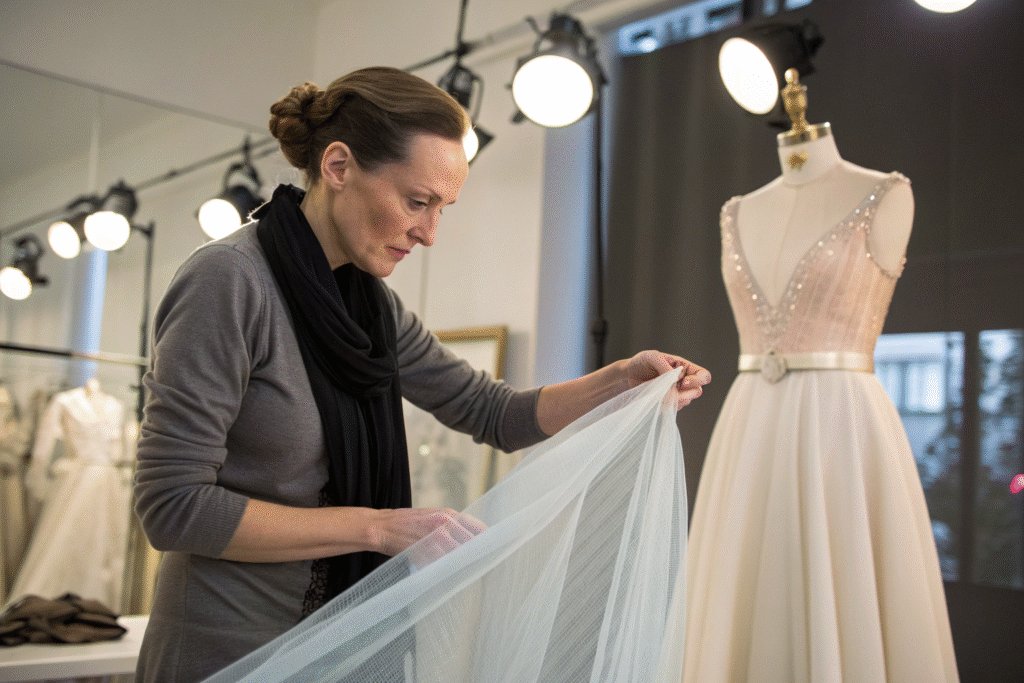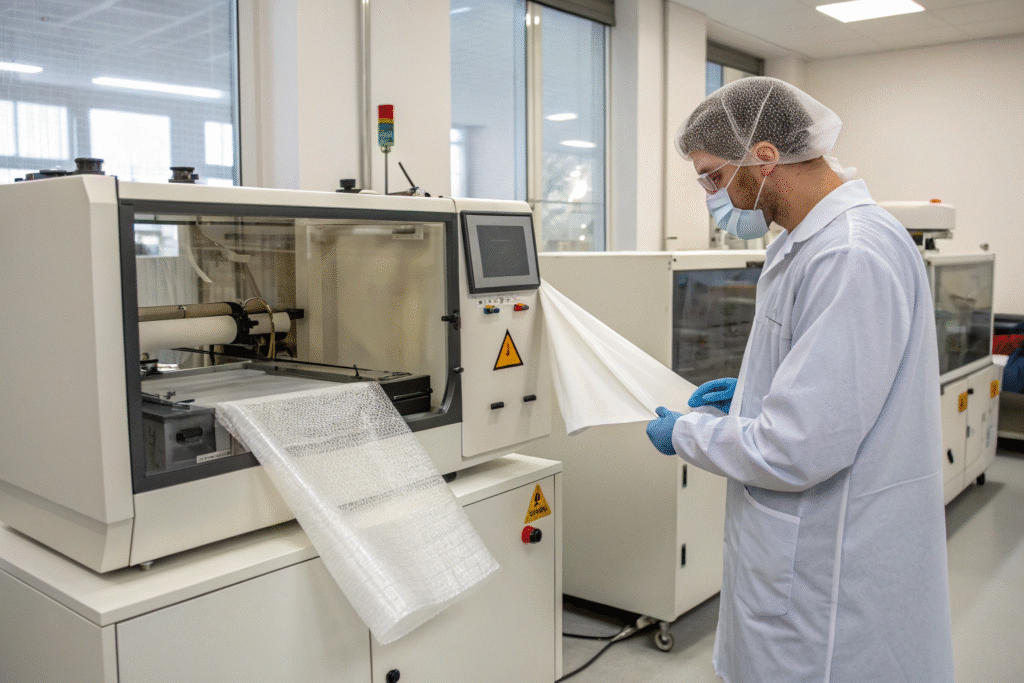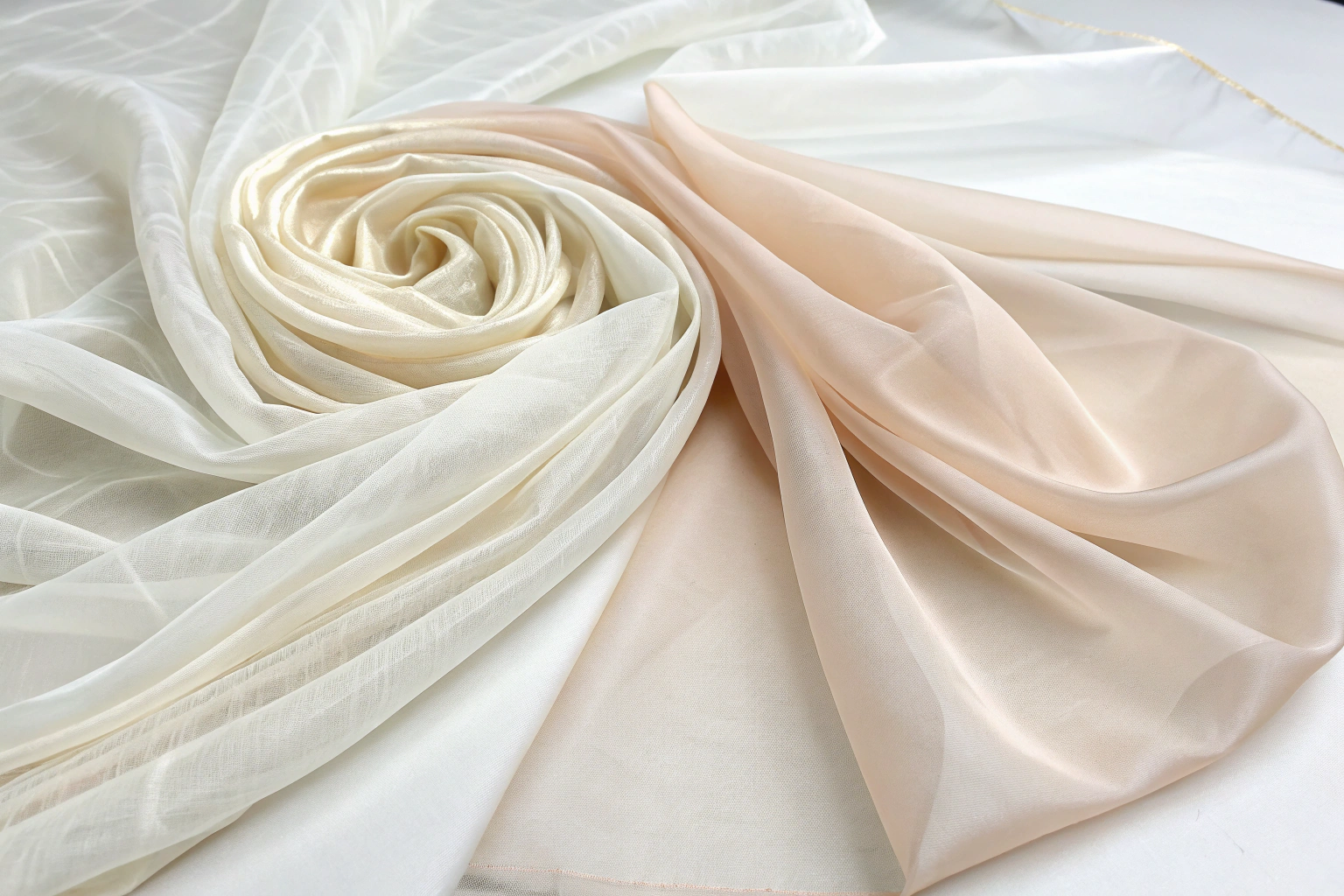When sourcing fabrics for your next fashion line, you might be stuck choosing between organza and voile. Both are lightweight and sheer, but they serve very different purposes in the world of apparel. Picking the wrong one can affect the drape, durability, and overall look of your final product. As a fabric expert with over 20 years in the textile industry, I see this confusion often, especially among brands looking for the perfect balance between elegance and everyday wear.
Organza is a crisp, sheer woven fabric known for its stiffness and structure, often used in formal wear and evening gowns. Voile is a soft, lightweight woven fabric with a smooth feel and slight stretch, ideal for flowing dresses, blouses, and curtains. The key difference lies in their texture and drape: organza holds its shape firmly, while voile offers a fluid, soft fall. Understanding these distinctions is crucial for designers and buyers to make the right choice for their specific garment needs.
Let's dive deeper into the unique characteristics of each fabric. We will explore their fibers, weaves, and best uses. This guide will help you decide which fabric is perfect for your next project.
What is organza fabric made of?
Organza is a delicate fabric that feels light but stands firm. It is traditionally made from silk, which gives it a natural sheen and strength. Today, you can also find organza made from synthetic fibers like polyester or nylon. These man-made options are more affordable and durable, making them popular for large-scale production. The fabric's signature crispness comes from a plain weave technique, where threads are woven tightly in a simple over-and-under pattern. This tight weave is what gives organza its body and slight scratchiness.

How does the weaving process affect organza's stiffness?
The plain weave used for organza is very basic but very tight. The warp and weft threads are twisted tightly before weaving. This creates a lot of friction and tension in the fabric. The result is a grid-like structure that is strong and resists bending. This is why organza doesn't drape softly but instead stands away from the body. It's this inherent stiffness that makes it perfect for creating volume in garments like ball gowns and providing shape in structured designs. For more on weaving techniques, the Textile Institute provides excellent resources.
What are the common uses of organza in fashion?
Organza's structure makes it a favorite for formal and decorative wear. It is often used as an overlay on wedding dresses and evening gowns to add fullness without weight. Designers use it for puffy sleeves, veils, and intricate appliqués because it holds its shape so well. Beyond clothing, organza is a staple in interior design for sheer curtains and in the craft industry for gift wrapping and floral arrangements. Its ability to hold vibrant dyes and accept embroidery makes it incredibly versatile for high-fashion details.
What is voile fabric best used for?
Voile is the opposite of organza. It is soft, fluid, and designed for comfort. It is most commonly made from 100% cotton or cotton blends, but you can also find silk and synthetic voiles. The fabric is woven using a plain weave as well, but the yarns are not tightly twisted. Instead, they are fine and combed, creating a soft, slightly elastic hand-feel. Voile is often treated with a chemical finish to make it more wrinkle-resistant and silky to the touch. This makes it a top choice for comfortable, everyday clothing that feels good against the skin.

Why is voile so popular for casual and summer wear?
Voile's breathability is its biggest asset. The loose plain weave allows air to circulate easily, keeping the wearer cool. Its soft drape means it moves with the body, making it ideal for loose, flowing silhouettes. You will find voile used in blouses, summer dresses, nightgowns, and children's clothing. It is also a preferred fabric for luxury linen and homeware items like high-end curtains and bedsheets because of its smooth, lustrous appearance. It's the go-to fabric by brands prioritizing comfort and a relaxed aesthetic.
How does voile handle printing and dyes?
Voile's smooth surface is excellent for printing. It absorbs dyes evenly, resulting in bright, clear patterns. This makes it a fantastic canvas for vibrant floral prints, paisleys, and other detailed designs. The fabric's slight transparency can add depth to printed patterns, creating a beautiful visual effect. For manufacturers, this means high-quality results with minimal waste. The Sustainable Apparel Coalition highlights the importance of choosing fabrics like voile that work well with eco-friendly dyes for reducing environmental impact.
Organza vs voile: Which is more durable?
Durability depends on the fiber content, not just the fabric type. A polyester organza is extremely strong and resistant to abrasion, tearing, and shrinking. Silk organza is strong but can be more delicate and may water-spot. Voile, typically made from cotton, is soft but can be less resistant to wear and tear over time, especially if it's a very fine weave. However, cotton voile becomes stronger when blended with synthetic fibers like polyester.
| Fabric | Fiber | Durability | Key Strengths |
|---|---|---|---|
| Organza | Polyester | Very High | Resists tearing, shrinking, and wrinkles. |
| Organza | Silk | Medium-High | Strong but can be delicate when wet. |
| Voile | Cotton | Medium | Soft and strong, but can pill with friction. |
| Voile | Cotton-Poly Blend | High | Combines softness with increased durability. |

How does fiber origin impact fabric longevity?
Man-made fibers are engineered for strength. Polyester, a common material for both organza and voile, has long polymer chains that make it very tough. This is why polyester organza is a workhorse in the industry for items that need to hold their shape through multiple wears. Natural silk is strong due to its long, continuous filaments, but it requires more careful handling. Cotton voile's durability comes from the staple length of the fibers; longer-staple cotton, like Egyptian or Pima, produces a more durable voile that resists pilling.
What quality control tests ensure fabric durability?
In our CNAS-accredited lab, we test for several key metrics. For organza, we focus on tear strength and stiffness retention. For voile, we prioritize pilling resistance and tensile strength. We use advanced QR code tracking to give buyers real-time access to this data for every batch. This ensures that the fabric you order meets the exact specifications for your product's lifespan, guaranteeing a 98% pass rate for our clients in international inspections.
How to choose between organza and voile?
The choice between organza and voile boils down to the desired aesthetic and function of your garment. You must ask yourself: What is the end use? Is it a structured, dramatic piece or a soft, comfortable everyday item? The decision tree is simple: choose organza for structure and volume; choose voile for drape and comfort. Consider your target market, price point, and the season for which you are designing.

What questions should you ask your fabric supplier?
Always request swatches and quality reports. Ask about the specific fiber content—is it 100% silk or a polyester blend? Inquire about the fabric's weight (GSM) and width. For organza, ask about the level of stiffness. For voile, ask about the thread count and whether it has a special finish. A reliable supplier, like us at Fumao, will provide all this information upfront. We also offer a 48-hour sample development service so you can feel and test the fabric before placing a bulk order.
How can a supplier help with logistics and cost-efficiency?
A good supplier does more than just sell fabric. They help you navigate the entire process. We offer integrated support from yarn sourcing to final packaging. Our logistics network ensures fast bulk delivery and streamlined customs clearance, which is crucial for the U.S. market. Because we are based in Keqiao, we have direct access to dyeing and weaving partners, which keeps costs competitive. More importantly, our production is not affected by US tariffs, providing you with significant cost savings and pricing stability that you can count on for your business planning.
Conclusion
Understanding the fundamental differences between organza and voile is key to making the right sourcing decision. Organza provides the structure and drama for high-fashion statements, while voile delivers the softness and flow for comfortable, wearable styles. Your choice will ultimately shape the look, feel, and function of your final product. As a fabric manufacturer with decades of experience, we've seen how the right fabric choice can define a collection's success.
We hope this guide empowers you to choose confidently. If you are ready to move forward with sourcing high-quality organza, voile, or any other fabric for your clothing line, we are here to help. Our team can guide you from material selection to final production. For a direct conversation about your needs, please contact our Business Director Elaine at elaine@fumaoclothing.com. Let's co-create value for your next big project.










